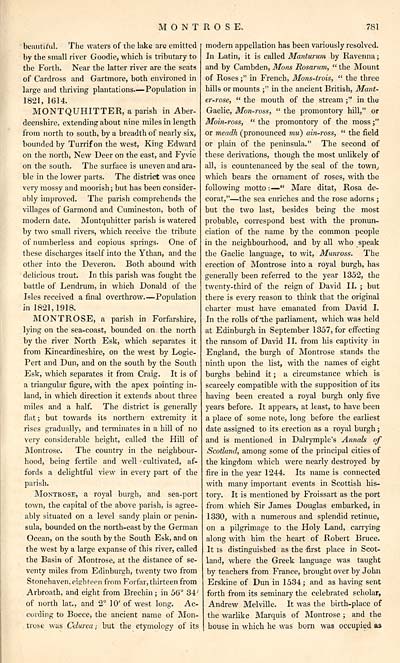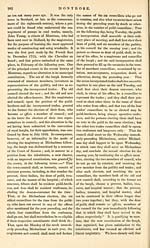Gazetteer of Scotland > Volume 2
(297) Page 781
Download files
Complete book:
Individual page:
Thumbnail gallery: Grid view | List view

MONTROSE.
781
beautiful. The waters of the lake are emitted
by the small river Goodie, which is tributary to
the Forth. Near the latter river are the seats
of Cardross and Gartmore, both environed in
large and thriving plantations.— Population in
1821, 1614.
MONTQUHITTER, a parish in Aber-
deenshire, extending about nine miles in length
from north to south, by a breadth of nearly six,
bounded by Turrif on the west, King Edward
on the north, New Deer on the east, and Fyvie
on the south. The surface is uneven and ara-
ble in the lower parts. The district was once
very mossy and moorish; but has been consider-
ably improved. The parish comprehends the
villages of Garmond and Cumineston, both of
modem date. Montquhitter parish is watered
by two small rivers, which receive the tribute
of numberless and copious springs. One of
these discharges itself into the Ythan, and the
other into the Deveron. Both abound with
delicious trout. In this parish was fought the
battle of Lendrum, in which Donald of the
Isles received a final overthrow — Population
in 1821, 1918.
MONTROSE, a parish in Forfarshire,
lying on the sea-coast, bounded on the north
by the river North Esk, which separates it
from Kincardineshire, on the west by Logie-
Pert and Dun, and on the south by the South
Esk, which separates it from Craig. It is of
a triangular figure, with the apex pointing in-
land, in which direction it extends about three
miles and a half. The district is generally
flat ; but towards its northern extremity it
rises gradually, and terminates in a hill of no
very considerable height, called the Hill of
Montrose. The country in the neighbour-
hood, being fertile and well - cultivated, af-
fords a delightful view in every part of the
parish.
Montrose, a royal burgh, and sea-port
town, the capital of the above parish, is agree-
ably situated on a level sandy plain or penin-
sula, bounded on the north-east by the German
Ocean, on the south by the South Esk, and on
the west by a large expanse of this river, called
the Basin of Montrose, at the distance of se-
venty miles from Edinburgh, twenty two from
Stonehaven, eighteen from Forfar, thirteen from
Arbroath, and eight from Brechin ; in 56° 34'
of north lat., and 2° 10' of west long. Ac-
cording to Boece, the ancient name of Mon-
trose was Celurea; but the etymology of its
modern appellation has been variously resolved.
In Latin, it is called Manturum by Ravenna;
and by Cambden, Mons Rosarum, " the Mount
of Roses ;" in French, Mons-trois, " the three
hills or mounts ;" in the ancient British, Mant-
er-rose, " the mouth of the stream ;" in the
Gaelic, Mon-ross, " the promontory hill," or
Moin-ross, " the promontory of the moss j"
or meadh (pronounced not) ain-ross, " the field
or plain of the peninsula." The second of
these derivations, though the most unlikely of
all, is countenanced by the seal of the town,
which bears the ornament of roses, with the
following motto :— " Mare ditat, Rosa de-
corat," — the sea enriches and the rose adorns ;
but the two last, besides being the most
probable, correspond best with the pronun-
ciation of the name by the common people
in the neighbourhood, and by all who speak
the Gaelic language, to wit, Munross. The
erection of Montrose into a royal burgh, has
generally been referred to the year 1352, the
twenty-third of the reign of David II. ; but
there is every reason to think that the original
charter must have emanated from David I.
In the rolls of the parliament, which was held
at Edinburgh in September 1357, for effecting
the ransom of David II. from his captivity in
England, the burgh of Montrose stands the
ninth upon the list, with the names of eight
burghs behind it ; a circumstance which is
scarcely compatible with the supposition of its
having been created a royal burgh only five
years before. It appears, at least, to have been
a place of some note, long before the earliest
date assigned to its erection as a royal burgh ;
and is mentioned in Dalrymple's Annals of
Scotland, among some of the principal cities of
the kingdom which were nearly destroyed by
fire in the year 1244. Its name is connected
with many important events in Scottish his-
tory. It is mentioned by Froissart as the port
from which Sir James Douglas embarked, in
1330, with a numerous and splendid retinue,
on a pilgrimage to the Holy Land, carrying
along with him the heart of Robert Bruce.
It is distinguished as the -first place in Scot-
land, where the Greek language was taught
by teachers from France, brought over by John
Erskine of Dun in 1534; and as having sent
forth from its seminary the celebrated scholar,
Andrew Melville. It was the birth-place of
the warlike Marquis of Montrose ; and the
house in which he was born was occupied as
781
beautiful. The waters of the lake are emitted
by the small river Goodie, which is tributary to
the Forth. Near the latter river are the seats
of Cardross and Gartmore, both environed in
large and thriving plantations.— Population in
1821, 1614.
MONTQUHITTER, a parish in Aber-
deenshire, extending about nine miles in length
from north to south, by a breadth of nearly six,
bounded by Turrif on the west, King Edward
on the north, New Deer on the east, and Fyvie
on the south. The surface is uneven and ara-
ble in the lower parts. The district was once
very mossy and moorish; but has been consider-
ably improved. The parish comprehends the
villages of Garmond and Cumineston, both of
modem date. Montquhitter parish is watered
by two small rivers, which receive the tribute
of numberless and copious springs. One of
these discharges itself into the Ythan, and the
other into the Deveron. Both abound with
delicious trout. In this parish was fought the
battle of Lendrum, in which Donald of the
Isles received a final overthrow — Population
in 1821, 1918.
MONTROSE, a parish in Forfarshire,
lying on the sea-coast, bounded on the north
by the river North Esk, which separates it
from Kincardineshire, on the west by Logie-
Pert and Dun, and on the south by the South
Esk, which separates it from Craig. It is of
a triangular figure, with the apex pointing in-
land, in which direction it extends about three
miles and a half. The district is generally
flat ; but towards its northern extremity it
rises gradually, and terminates in a hill of no
very considerable height, called the Hill of
Montrose. The country in the neighbour-
hood, being fertile and well - cultivated, af-
fords a delightful view in every part of the
parish.
Montrose, a royal burgh, and sea-port
town, the capital of the above parish, is agree-
ably situated on a level sandy plain or penin-
sula, bounded on the north-east by the German
Ocean, on the south by the South Esk, and on
the west by a large expanse of this river, called
the Basin of Montrose, at the distance of se-
venty miles from Edinburgh, twenty two from
Stonehaven, eighteen from Forfar, thirteen from
Arbroath, and eight from Brechin ; in 56° 34'
of north lat., and 2° 10' of west long. Ac-
cording to Boece, the ancient name of Mon-
trose was Celurea; but the etymology of its
modern appellation has been variously resolved.
In Latin, it is called Manturum by Ravenna;
and by Cambden, Mons Rosarum, " the Mount
of Roses ;" in French, Mons-trois, " the three
hills or mounts ;" in the ancient British, Mant-
er-rose, " the mouth of the stream ;" in the
Gaelic, Mon-ross, " the promontory hill," or
Moin-ross, " the promontory of the moss j"
or meadh (pronounced not) ain-ross, " the field
or plain of the peninsula." The second of
these derivations, though the most unlikely of
all, is countenanced by the seal of the town,
which bears the ornament of roses, with the
following motto :— " Mare ditat, Rosa de-
corat," — the sea enriches and the rose adorns ;
but the two last, besides being the most
probable, correspond best with the pronun-
ciation of the name by the common people
in the neighbourhood, and by all who speak
the Gaelic language, to wit, Munross. The
erection of Montrose into a royal burgh, has
generally been referred to the year 1352, the
twenty-third of the reign of David II. ; but
there is every reason to think that the original
charter must have emanated from David I.
In the rolls of the parliament, which was held
at Edinburgh in September 1357, for effecting
the ransom of David II. from his captivity in
England, the burgh of Montrose stands the
ninth upon the list, with the names of eight
burghs behind it ; a circumstance which is
scarcely compatible with the supposition of its
having been created a royal burgh only five
years before. It appears, at least, to have been
a place of some note, long before the earliest
date assigned to its erection as a royal burgh ;
and is mentioned in Dalrymple's Annals of
Scotland, among some of the principal cities of
the kingdom which were nearly destroyed by
fire in the year 1244. Its name is connected
with many important events in Scottish his-
tory. It is mentioned by Froissart as the port
from which Sir James Douglas embarked, in
1330, with a numerous and splendid retinue,
on a pilgrimage to the Holy Land, carrying
along with him the heart of Robert Bruce.
It is distinguished as the -first place in Scot-
land, where the Greek language was taught
by teachers from France, brought over by John
Erskine of Dun in 1534; and as having sent
forth from its seminary the celebrated scholar,
Andrew Melville. It was the birth-place of
the warlike Marquis of Montrose ; and the
house in which he was born was occupied as
Set display mode to: Large image | Transcription
Images and transcriptions on this page, including medium image downloads, may be used under the Creative Commons Attribution 4.0 International Licence unless otherwise stated. ![]()
| Gazetteers of Scotland, 1803-1901 > Gazetteer of Scotland > Volume 2 > (297) Page 781 |
|---|
| Permanent URL | https://digital.nls.uk/97434386 |
|---|
| Description | Volume II: Glenbanchor to Zetland. |
|---|---|
| Attribution and copyright: |
|
| Description | By Robert Chambers and William Chambers. Glasgow: Blackie & Son, 1838. 2 volumes. |
|---|---|
| Shelfmark | NF.1461.g.7 |
| Additional NLS resources: | |

